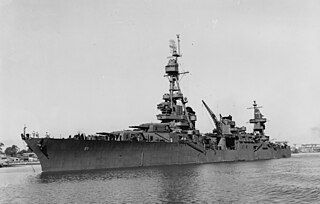
USS Chester (CL/CA-27), a Northampton-class cruiser, was the second ship of the United States Navy named after the city of Chester, Pennsylvania.

The second USS Cummings (DD-365) was a Mahan-class destroyer in the United States Navy, named for Andrew Boyd Cummings. She was a Pacific-based vessel, performing patrol and escort duties before and during World War II. The ship was present during the Attack on Pearl Harbor by the Japanese on 7 December 1941, though she escaped major damage or casualties. Cummings was decommissioned in 1945 and sold for scrap in 1947.

Mahan-class destroyers of the United States Navy were a series of 18 destroyers of which the first 16 were laid down in 1934. The last two of the 18, Dunlap and Fanning, are sometimes considered a separate ship class. All 18 were commissioned in 1936 and 1937. Mahan was the lead ship, named for Rear Admiral Alfred Thayer Mahan, an influential historian and theorist on sea power.

USS Halligan (DD-584) was a Fletcher-class destroyer of the United States Navy, named for Rear Admiral John Halligan, Jr. (1876–1934).

USS Gilmer (DD-233/APD-11) was a Clemson-class destroyer in the United States Navy during World War II. She was the first ship named for Secretary of the Navy Thomas Walker Gilmer.

USS Izard (DD-589), a Fletcher-class destroyer, was a ship of the United States Navy named for Lieutenant Ralph Izard (1785–1822),

The first USS Dewey (DD-349) was a Farragut-class destroyer of the United States Navy, launched in 1934 and named for Admiral George Dewey. Dewey served in the Pacific through World War II. After escaping damage during the Attack on Pearl Harbor, Dewey screened the aircraft carrier USS Lexington until the carrier was lost in the Battle of the Coral Sea; then screened USS Saratoga through the Invasion of Guadalcanal and the Battle of the Eastern Solomons. Following overhaul in San Francisco, Dewey spent 1943 in Alaskan waters supporting the invasions of Attu and Kiska. Dewey spent 1944 supporting raids in the Marshalls, Carolines, and Marianas, including screening carriers during the Battle of the Philippine Sea. After being damaged by Typhoon Cobra during the Recapture of the Philippines, Dewey supported the invasion of Iwo Jima and spent the remainder of the war screening replenishment oilers.

USS Hyman (DD-732), was an Allen M. Sumner-class destroyer of the United States Navy.

USS Patterson (DD-392), a Bagley-class destroyer, was the second ship of the United States Navy to be named for Daniel Todd Patterson, an officer of the US Navy who served in the Quasi-War with France, First Barbary War, and the War of 1812.

USS Case (DD-370) was a Mahan-class destroyer in the United States Navy before and during World War II. She was the second ship named for Augustus Ludlow Case. Case was berthed at Pearl Harbor when the Japanese struck on 7 December 1941, then served in the United States Pacific Fleet until the end of World War II.

USS Downes (DD-375) was a Mahan-class destroyer in the United States Navy before and during World War II. She was the second ship named for John Downes, a US Navy officer.

USS Dunlap (DD–384) was a Mahan-class destroyer in the United States Navy before and during World War II. She was named after Brigadier General Robert H. Dunlap, USMC. In some references, she is listed as a Dunlap-class destroyer. Captain was Clifton Iverson, who earned the Navy Cross during the Battle of Vella Gulf

USS Fanning (DD-385) was a Mahan-class destroyer, in the United States Navy named for Nathaniel Fanning. Her first action was during World War II, immediately following the 7 December 1941 attack on Pearl Harbor. Fanning continued to serve in the Pacific Theatre throughout the war, and was decommissioned 14 December 1945. He was one of the last Mahan-class destroyers. Fanning and USS Dunlap were built from the same basic Mahan design but slightly modified. Some sources refer to them as the Dunlap-class destroyers.

USS Highlands (APA-119) was a Haskell-class attack transport built and used by the US Navy in World War II. She was a Victory ship design, VC2-S-AP5. She was named after Highlands County, Florida, United States.

USS Halloran (DE-305) was a Evarts-class destroyer escort of the United States Navy.

USS Donaldson (DE-44) was an Evarts-class destroyer escort of the United States Navy during World War II. She was sent off into the Pacific Ocean to protect convoys and other ships from Japanese submarines and fighter aircraft. She performed escort and anti-submarine operations in dangerous battle areas and was awarded seven battle stars, a very high number for a ship of her type.

USS Dionne (DE-261) was an Evarts-class destroyer escort of the United States Navy during World War II. She was sent off into the Pacific Ocean to protect convoys and other ships from Japanese submarines and fighter aircraft. She performed escort and antisubmarine operations in dangerous battle areas and returned home with six battle stars, a high number for a ship of her type.

USS Riddle (DE-185) was a Cannon-class destroyer escort in service with the United States Navy from 1943 to 1946. In 1950, she was transferred to France where she served as Kabyle (F718) until being decommissioned and scrapped in 1959.

USS Otterstetter (DE-244) was an Edsall-class destroyer escort built for the U.S. Navy during World War II. She served in the Atlantic Ocean the Pacific Ocean and provided destroyer escort protection against submarine and air attack for Navy vessels and convoys.

USS Richard S. Bull (DE-402) was a John C. Butler-class destroyer escort in service with the United States Navy from 1944 to 1946. She was finally sunk as a target in 1969.






















